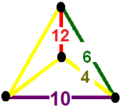In the field of hyperbolic geometry, the order-5 hexagonal tiling honeycomb arises as one of 11 regular paracompact honeycombs in 3-dimensional hyperbolic space. It is paracompact because it has cells composed of an infinite number of faces. Each cell consists of a hexagonal tiling whose vertices lie on a horosphere, a flat plane in hyperbolic space that approaches a single ideal point at infinity.
The Schläfli symbol of the order-5 hexagonal tiling honeycomb is {6,3,5}. Since that of the hexagonal tiling is {6,3}, this honeycomb has five such hexagonal tilings meeting at each edge. Since the Schläfli symbol of the icosahedron is {3,5}, the vertex figure of this honeycomb is an icosahedron. Thus, 20 hexagonal tilings meet at each vertex of this honeycomb. [1]
A geometric honeycomb is a space-filling of polyhedral or higher-dimensional cells, so that there are no gaps. It is an example of the more general mathematical tiling or tessellation in any number of dimensions.
Honeycombs are usually constructed in ordinary Euclidean ("flat") space, like the convex uniform honeycombs. They may also be constructed in non-Euclidean spaces, such as hyperbolic uniform honeycombs. Any finite uniform polytope can be projected to its circumsphere to form a uniform honeycomb in spherical space.
The order-5 hexagonal tiling honeycomb is a regular hyperbolic honeycomb in 3-space, and one of 11 which are paracompact.
| 11 paracompact regular honeycombs |
|---|

{6,3,3} | 
{6,3,4} | 
{6,3,5} | 
{6,3,6} | 
{4,4,3} | 
{4,4,4} |

{3,3,6} | 
{4,3,6} | 
{5,3,6} | 
{3,6,3} | 
{3,4,4} |
There are 15 uniform honeycombs in the [6,3,5] Coxeter group family, including this regular form, and its regular dual, the order-6 dodecahedral honeycomb.
[6,3,5] family honeycombs| {6,3,5} | r{6,3,5} | t{6,3,5} | rr{6,3,5} | t0,3{6,3,5} | tr{6,3,5} | t0,1,3{6,3,5} | t0,1,2,3{6,3,5} |
|---|
 |  |  |  |  |  |  |  |
 |  |  |  |  |  |  |
| {5,3,6} | r{5,3,6} | t{5,3,6} | rr{5,3,6} | 2t{5,3,6} | tr{5,3,6} | t0,1,3{5,3,6} | t0,1,2,3{5,3,6} |
|---|
The order-5 hexagonal tiling honeycomb has a related alternation honeycomb, represented by 





 ↔
↔ 



 , with icosahedron and triangular tiling cells.
, with icosahedron and triangular tiling cells.
It is a part of sequence of regular hyperbolic honeycombs of the form {6,3,p}, with hexagonal tiling facets:
| {6,3,p} honeycombs |
|---|
| Space | H3 |
|---|
| Form | Paracompact | Noncompact |
|---|
| Name | {6,3,3} | {6,3,4} | {6,3,5} | {6,3,6} | {6,3,7} | {6,3,8} | ... {6,3,∞} |
|---|
Coxeter
      
       |        |       
    
       |        |       
    
       |        |       
      |       
     
 |
|---|
| Image |  |  |  |  |  |  |  |
|---|
Vertex
figure
{3,p}
     | 
{3,3}
     | 
{3,4}
    
   | 
{3,5}
     | 
{3,6}
    
   | 
{3,7}
     | 
{3,8}
    
    | 
{3,∞}
    
    |
|---|
It is also part of a sequence of regular polychora and honeycombs with icosahedral vertex figures:
| {p,3,5} polytopes |
|---|
| Space | S3 | H3 |
|---|
| Form | Finite | Compact | Paracompact | Noncompact |
|---|
| Name | {3,3,5}
       | {4,3,5}
       | {5,3,5}
       | {6,3,5}
       | {7,3,5}
       | {8,3,5}
       | ... {∞,3,5}
       |
|---|
| Image |  |  |  |  |  |  |  |
|---|
| Cells | 
{3,3}
     | 
{4,3}
     | 
{5,3}
     | 
{6,3}
     | 
{7,3}
     | 
{8,3}
     | 
{∞,3}
     |
|---|
Rectified order-5 hexagonal tiling honeycomb
| Rectified order-5 hexagonal tiling honeycomb |
|---|
| Type | Paracompact uniform honeycomb |
| Schläfli symbols | r{6,3,5} or t1{6,3,5} |
| Coxeter diagrams |       
       ↔ ↔      |
| Cells | {3,5} 
r{6,3} or h2{6,3}
  |
| Faces | triangle {3}
hexagon {6} |
| Vertex figure | 
pentagonal prism |
| Coxeter groups |  , [5,3,6] , [5,3,6]
 , [5,3[3]] , [5,3[3]] |
| Properties | Vertex-transitive, edge-transitive |
The rectified order-5 hexagonal tiling honeycomb, t1{6,3,5}, 





 has icosahedron and trihexagonal tiling facets, with a pentagonal prism vertex figure.
has icosahedron and trihexagonal tiling facets, with a pentagonal prism vertex figure.

It is similar to the 2D hyperbolic infinite-order square tiling, r{∞,5} with pentagon and apeirogonal faces. All vertices are on the ideal surface.
-

r{p,3,5}| Space | S3 | H3 |
|---|
| Form | Finite | Compact | Paracompact | Noncompact |
|---|
| Name | r{3,3,5}
       | r{4,3,5}
      
     | r{5,3,5}
       | r{6,3,5}
      
     | r{7,3,5}
       | ... r{∞,3,5}
      
      |
|---|
| Image |  |  |  |  | | |
|---|
Cells

{3,5}
     | 
r{3,3}
     | 
r{4,3}
     | 
r{5,3}
     | 
r{6,3}
     | 
r{7,3}
     | 
r{∞,3}
     |
|---|
Truncated order-5 hexagonal tiling honeycomb
| Truncated order-5 hexagonal tiling honeycomb |
|---|
| Type | Paracompact uniform honeycomb |
| Schläfli symbol | t{6,3,5} or t0,1{6,3,5} |
| Coxeter diagram |        |
| Cells | {3,5} 
t{6,3}  |
| Faces | triangle {3}
dodecagon {12} |
| Vertex figure | 
pentagonal pyramid |
| Coxeter groups |  , [5,3,6] , [5,3,6] |
| Properties | Vertex-transitive |
The truncated order-5 hexagonal tiling honeycomb, t0,1{6,3,5}, 





 has icosahedron and truncated hexagonal tiling facets, with a pentagonal pyramid vertex figure.
has icosahedron and truncated hexagonal tiling facets, with a pentagonal pyramid vertex figure.

Bitruncated order-5 hexagonal tiling honeycomb
| Bitruncated order-5 hexagonal tiling honeycomb |
|---|
| Type | Paracompact uniform honeycomb |
| Schläfli symbol | 2t{6,3,5} or t1,2{6,3,5} |
| Coxeter diagram |       
       ↔ ↔      |
| Cells | t{3,6} 
t{3,5}  |
| Faces | pentagon {5}
hexagon {6} |
| Vertex figure | 
digonal disphenoid |
| Coxeter groups |  , [5,3,6] , [5,3,6]
 , [5,3[3]] , [5,3[3]] |
| Properties | Vertex-transitive |
The bitruncated order-5 hexagonal tiling honeycomb, t1,2{6,3,5}, 





 has hexagonal tiling and truncated icosahedron facets, with a digonal disphenoid vertex figure.
has hexagonal tiling and truncated icosahedron facets, with a digonal disphenoid vertex figure.

Cantellated order-5 hexagonal tiling honeycomb
| Cantellated order-5 hexagonal tiling honeycomb |
|---|
| Type | Paracompact uniform honeycomb |
| Schläfli symbol | rr{6,3,5} or t0,2{6,3,5} |
| Coxeter diagram |        |
| Cells | r{3,5} 
rr{6,3} 
{}x{5}  |
| Faces | triangle {3}
square {4}
pentagon {5}
hexagon {6} |
| Vertex figure | 
wedge |
| Coxeter groups |  , [5,3,6] , [5,3,6] |
| Properties | Vertex-transitive |
The cantellated order-5 hexagonal tiling honeycomb, t0,2{6,3,5}, 





 has icosidodecahedron, rhombitrihexagonal tiling, and pentagonal prism facets, with a wedge vertex figure.
has icosidodecahedron, rhombitrihexagonal tiling, and pentagonal prism facets, with a wedge vertex figure.

Cantitruncated order-5 hexagonal tiling honeycomb
| Cantitruncated order-5 hexagonal tiling honeycomb |
|---|
| Type | Paracompact uniform honeycomb |
| Schläfli symbol | tr{6,3,5} or t0,1,2{6,3,5} |
| Coxeter diagram |        |
| Cells | t{3,5} 
tr{6,3} 
{}x{5}  |
| Faces | square {4}
pentagon {5}
hexagon {6}
dodecagon {12} |
| Vertex figure | 
mirrored sphenoid |
| Coxeter groups |  , [5,3,6] , [5,3,6] |
| Properties | Vertex-transitive |
The cantitruncated order-5 hexagonal tiling honeycomb, t0,1,2{6,3,5}, 





 has truncated icosahedron, truncated trihexagonal tiling, and pentagonal prism facets, with a mirrored sphenoid vertex figure.
has truncated icosahedron, truncated trihexagonal tiling, and pentagonal prism facets, with a mirrored sphenoid vertex figure.

Runcitruncated order-5 hexagonal tiling honeycomb
The runcitruncated order-5 hexagonal tiling honeycomb, t0,1,3{6,3,5}, 





 has truncated hexagonal tiling, rhombicosidodecahedron, pentagonal prism, and dodecagonal prism cells, with an isosceles-trapezoidal pyramid vertex figure.
has truncated hexagonal tiling, rhombicosidodecahedron, pentagonal prism, and dodecagonal prism cells, with an isosceles-trapezoidal pyramid vertex figure.

Omnitruncated order-5 hexagonal tiling honeycomb
| Omnitruncated order-5 hexagonal tiling honeycomb |
|---|
| Type | Paracompact uniform honeycomb |
| Schläfli symbol | t0,1,2,3{6,3,5} |
| Coxeter diagram |        |
| Cells | tr{6,3} 
tr{5,3} 
{}x{10} 
{}x{12}  |
| Faces | square {4}
hexagon {6}
decagon {10}
dodecagon {12} |
| Vertex figure | 
irregular tetrahedron |
| Coxeter groups |  , [5,3,6] , [5,3,6] |
| Properties | Vertex-transitive |
The omnitruncated order-5 hexagonal tiling honeycomb, t0,1,2,3{6,3,5}, 





 has truncated trihexagonal tiling, truncated icosidodecahedron, decagonal prism, and dodecagonal prism facets, with an irregular tetrahedral vertex figure.
has truncated trihexagonal tiling, truncated icosidodecahedron, decagonal prism, and dodecagonal prism facets, with an irregular tetrahedral vertex figure.

Runcicantic order-5 hexagonal tiling honeycomb
The runcicantic order-5 hexagonal tiling honeycomb, h2,3{6,3,5}, 





 ↔
↔ 



 , has trihexagonal tiling, truncated icosidodecahedron, truncated dodecahedron, and triangular prism facets, with a rectangular pyramid vertex figure.
, has trihexagonal tiling, truncated icosidodecahedron, truncated dodecahedron, and triangular prism facets, with a rectangular pyramid vertex figure.
This page is based on this
Wikipedia article Text is available under the
CC BY-SA 4.0 license; additional terms may apply.
Images, videos and audio are available under their respective licenses.

 ↔
↔ 


























































